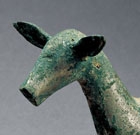J.J. Lally & Co., Oriental Art / New York City, New York
MenuPast Exhibition
Arts of Ancient China
March 27 - April 12, 2006
19.
A PAIR OF ORDOS BRONZE KULANS
Northwest China, 4th Century B.C.
each simply modeled figure of a wild ass shown in a realistic walking pose with small hooves attached to a rough horizontal base, the slender bodies smoothly contoured and showing a fine central ridge left from the piece-mold casting technique, the head very simply rendered and finished in a blunt nose, the rump with a short tail, the characteristic long slender ears shown pricked up on one kulan and extended out to either side on the other, the tinned surface of the bronze with a silvery luster and showing widely scattered bright green cuprite encrustation and traces of earth from burial.
Lengths 4 inches and 4 1⁄4 inches (10.2 cm and 10.8 cm)
Kulans were common to the grasslands of China’s northern frontier, but bronze figures cast in the round such as these are relatively rare. Compare the pair of finials in the form of kulans, from the collection of E.V. Thaw, included in the exhibition at the Metropolitan Museum of Art and illustrated by Bunker, Watt and Sun in the catalogue entitled Nomadic Art of the Eastern Eurasian Steppes, New York, 2002, no. 38, p. 71.
西元前四世紀 鄂爾多斯式銅驢一對
長 10.2 厘米 及 10.8 厘米
